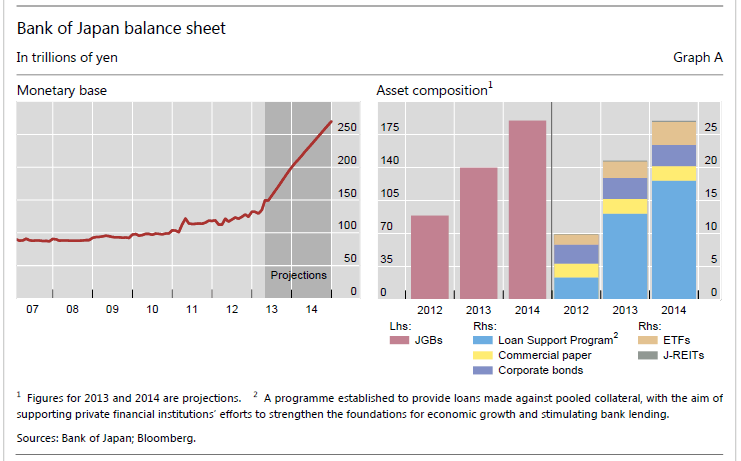Monetary policy easing in Japan
(Extract from page 5 of BIS Quarterly Review, June 2013)
On 4 April, the Bank of Japan (BOJ) unveiled a new policy framework aimed at ending deflation, known as Quantitative and Qualitative Monetary Easing (QQE).
The framework changes the central bank's operational target from the overnight rate to the monetary base, and stresses the importance of communication. To enhance clarity and simplicity it gives prominence to the number 2. It sets a 2% price stability target to be reached as soon as possible, with a horizon of about two years. It also calls for doubling the monetary base and the central bank's holdings of JGBs and exchange-traded funds (ETFs) in two years, as well as more than doubling the average maturity of the JGB portfolio.
The BOJ intends to increase the monetary base by ¥60-70 trillion per year to ¥270 trillion by the end of 2014, or nearly 60% of nominal GDP. It also aims to compress interest rates across the yield curve by expanding JGB holdings by ¥50 trillion annually and extending the average remaining maturity of its JGB holdings from the current level of slightly less than three years to about seven years. Moreover, it will increase holdings of risky assets by purchasing ¥1 trillion of ETFs and ¥30 billion of real estate investment trusts (J-REITs) annually (Graph A). According to the central bank, the "qualitative" aspects of monetary easing refer to the effects of the maturity extension putting downward pressure on the entire yield curve, and the expected compression of risk premia on risk assets.
The framework is intended to work through three channels. First, the BOJ expects its purchases of financial assets to lower interest rates across the yield curve and to reduce risk premia in asset prices (the interest rate channel). Second, it expects those changes to encourage financial institutions and institutional investors to rebalance their portfolios towards loans and/or risk assets (the portfolio rebalancing effect). Finally, and strongly emphasised by the BOJ, the new framework represents a clear commitment to achieving the price stability target as soon as possible and to continuing the massive asset purchases that underpin it, in order to help shift economic agents' expectations drastically (the expectations channel) and thus raise inflation expectations, leading to a decrease in real interest rates.

